Home > Products > DURANEX(R) PBT
Introducing Materials and Technologies for ADAS Parts
Introducing Materials and Technologies for ADAS Parts |
|---|
| 1. Introduction |
The automotive industry is undergoing a great change that is said to occur only once every hundred years, and CASE (Connected, Autonomous, Shared & Service, Electric) is becoming an important keyword. The shift from internal combustion cars to electric cars will do away with existing engine and fuel system parts, replacing them with electrical and electronic components, and battery components. At the same time, ADAS (Advanced Driver-Assistance Systems) parts that enable autonomous driving are also increasing. Autonomous driving levels are based on definitions by the Society of Automotive Engineers (SAE). Levels 0 through 2 (partial automation) are considered ADAS, while Levels 3 and above are considered autonomous driving. Models equipped with Level 2 are already available on the market. This may be obvious, but when a car is driving, the driver is doing three things: seeing, deciding, and operating. With ADAS, parts perform some of these movements instead of the driver. These can be broadly categorized as sensors seeing, the Electronic Control Unit (ECU) deciding, and the actuator operating. Communication equipment plays an important role in supporting things that the sensors cannot see, and the communication network is important in connecting the various parts. |
Table 1 : Overview of Autonomous Driving Level Definitions |
| Source: Website of Cabinet Office, Government of Japan |
SAE level |
Overview |
Who monitors and responds for safe driving | |||||
Driver performs all orpart of driving tasks |
Level 0: No Automation |
|
Driver | ||||
| Level 1: Driver Assistance |
|
Driver | |||||
| Level 2: Partial Automation |
|
Driver | |||||
Autonomous driving system performs all driving tasks |
Level 3: Conditional Automation |
|
System (driver when struggles to continue driving) | ||||
| Level 4: High Automation |
|
System | |||||
| Level 5: Full Automation |
|
System |
* These ranges are not necessarily limited to geographical ranges but also include environment, traffic, speed, time-related conditions, and more. |
| 2. ADAS parts which include engineering plastics |
ADAS parts are the sensors that monitor the surroundings, the actuator which operates the car, communication equipment for cars to communicate with each other and roadside infrastructure, and the ECU which makes decisions. Also, as ADAS becomes more sophisticated each of the parts sends and receives increasing volumes of data, which requires high-speed communication. 5G communication is also becoming more widespread, so high-speed and high-frequency transmission parts are expected to increase. Illustration 1 shows some examples of ADAS parts which include engineering plastics. From among these parts, we will go into more detail about engineering plastics for actuator parts and for communication equipment. |
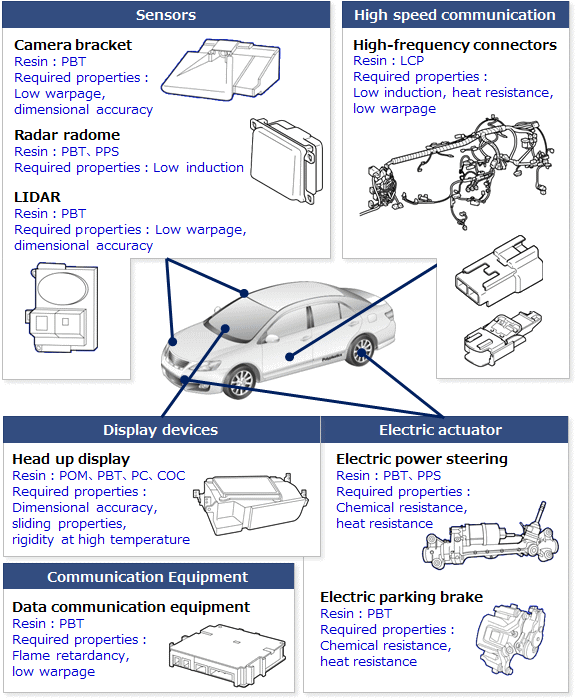 |
Illustration 1: Autonomous driving-related parts in which engineering plastics and super engineering plastics are used |
|---|
| 3. Materials for actuator parts |
In recent years parts for actuators in cars have been going electric, and the By-wire system is coming into more widespread use. The conventional by wire system only had a throttle that adjusts the air intake of the engine. Recently the by wire system has also expanded to include the shift of the transmission, the parking brake, the steering, and the brakes of the car. The By wire system uses electrical signals to control the actuator, so it requires insulation materials (resin). Also, as ADAS becomes more sophisticated its controls become partially automated, so the related products need to be highly reliable in operation. For that reason, progress is being made in designs which take redundancy into consideration such as making two systems with the power and signal circuits. Along with these changes, actuator parts are now expected to be highly reliable and not break down even when placed in harsh environments. Similarly, the resins that are used in these parts are also expected to be highly reliable (long service life). Polyplastics DURANEX® PBT is chosen for use in many electric actuator parts because it capably continues to perform even in the harsh environments that parts are exposed to in cars. Here we will share some examples of usage applications for Polyplastics products. |
| DURANEX® PBT grades with superior durability even in environments exposed to water |
Since they are close to the road, parts on the bottom of cars are exposed to water and snow melting agent from road surfaces as well as oil and other substances. These parts also heat up since they are close to the engine, motor, and other parts that generate heat. As a result, PBT is chosen for use in many actuator parts due to its high heat resistance, superior chemical resistance, and low rate of property changes from water absorption. DURANEX 330HR, 531HS, and 532AR are grades with the superior durability (hydrolysis resistance) to withstand conditions such as these. Table 2 shows the mechanism of heat shock fracture. 531HS, and 532AR have heat shock resistance, and are also compatible with the increase in insert metals due to redundancy design (Table 2) Metal parts on the bottom of cars come into contact with water and snow melting agent at high temperatures and are therefore prone to rust. In addition to corroding and rusting, iron is also susceptible to the formation of alkali matter when rusting occurs. This alkali matter can come into contact with resin parts and cause the resin to crack (stress cracking). Preventing stress cracking requires either (1) use of alkaline-resistant resin, or (2) measures to prevent corrosion in metals. 532AR has resistance to alkali matter (Illustrations 3, 4) and is a grade which does not easily experience stress cracking even if it comes into contact with rust fluid from metal. This makes it optimal for parts on the bottom of cars. |
| Table 2: Properties of DURANEX® PBT Grades |
Grade |
Characteristic |
Mechanical |
Hydrolysis resistance |
Heat shock resistance |
Alkali resistance |
532AR |
GF30% Alkali-resistant |
● |
● |
● |
● |
531HS |
GF30% Alkali-resistant |
● |
● |
● |
|
330HR |
GF30% Hydrolysis-resistant |
● |
● |
||
3300 |
GF30% Standard |
● |
 |
Illustration 2: Mechanism of heat shock fracture |
|---|
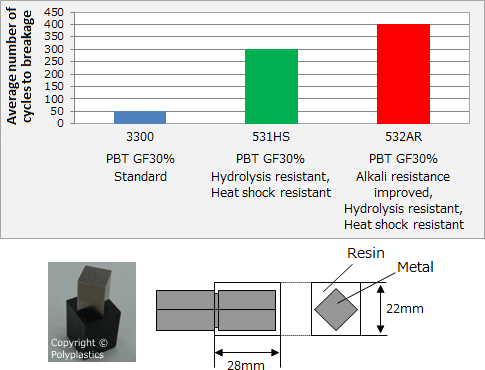 |
Illustration 3: DURANEX® PBT Heat Shock Resistance (-40℃ ⇔ 140℃/cycle) |
|---|
<Testing method> • Cut the weld part of a 80mm × 80mm × 1mmt test piece with holes into strip form • Load the strip-form test piece with 1% strain, and immerse it in strongly alkaline 10% sodium hydroxide solution at room temperature • Measure the time it takes for cracking to occur in the strain-loaded strip-form test piece |
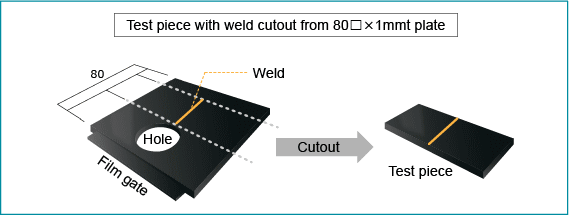 |
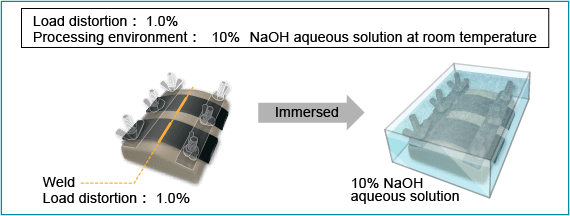 |
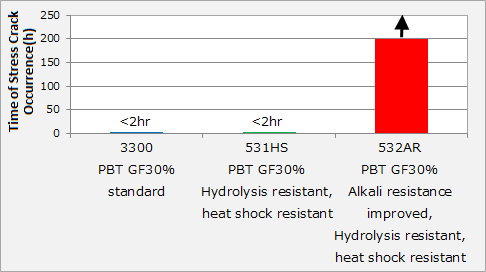 |
Figure 4 : Alkali resistance stress cracking evaluation results for DURANEX® PBT |
|---|
| 4. Materials for communication equipment |
Along with the electrification of cars, flame retardancy of resin is required in an increasing number of cases each year. Resin with flame retardancy is often used for resin applications in motors exposed to high voltages, batteries, and charging parts. Apart from these applications, resin with flame retardancy has also been used in data communication equipment for vehicle-to-everything (V2X) in recent years. V2X is a necessary technology for the practical use of autonomous driving (SAE Level 3 or higher), and more car models are expected to be equipped with it going forward. Engineering plastics are used in the cases and connectors for this data communication equipment. In addition to flame retardancy, these engineering plastics also need to have high durability and dimensional accuracy in car-mounted environments. Polyplastics DURANEX has grades that are certified (UL standard V-0) as flame retardant materials and are used for many car-mounted parts. DURANEX 750AM in particular has a high level of durability in car-mounted environments. Since it also possesses the ability to stabilize the shapes of cases and connectors, this grade is increasingly being used in auto parts that require flame retardancy in recent years. |
| DURANEX® PBT 750AM with flame retardancy and superior dimensional stability |
PA66 and PBT are often used in a variety of different cases and connectors as materials that have a constant level of mechanical properties and chemical resistance in temperature conditions from -40℃ to 140℃ that cars require. Each of the two materials has its own characteristics, but currently PBT is being used for an increasing number of applications due to its stable supply. Below are some examples of 750AM in use for auto parts that require flame retardancy (Illustrations 5, 6). In addition to at least the same level of low warpage and durability (hydrolysis resistance) as 733LD which has an extensive track record of use in the engine rooms of cars, this grade also has flame retardancy. It has enough of the durability and high shape stability required in the automotive sector and is an ideal material for EV and HEV parts, communication equipment, and more. |
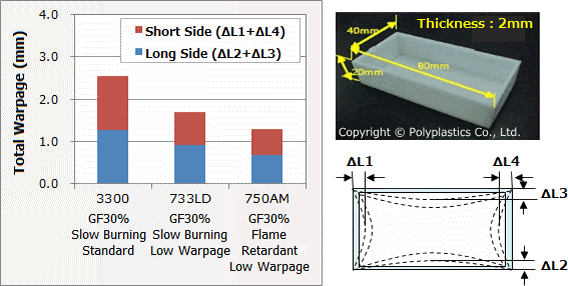 |
Illustration 5: DURANEX® PBT 750AM Warpage Deformation |
|---|
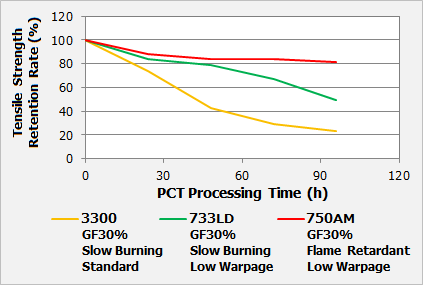 |
Illustration 6: DURANEX® PBT 750AM Hydrolysis Resistance Properties |
|---|
| 5. Conclusion |
This article has focused on materials for actuator parts and communication equipment in ADAS. We will also introduce trends in materials for ADAS sensor parts on another occasion. As a manufacturer that specializes in engineering plastics, Polyplastics will continue developing materials that optimally satisfy market needs. |
Technical data sheet is available online: |
|
||
For inquiries about our technologies |
◆Polyplastics Group Representative | ||
| ◆WEB Inquiry |
13th July 2020 |

